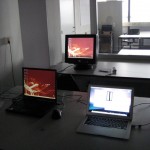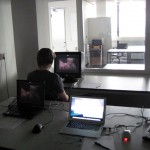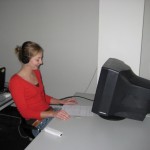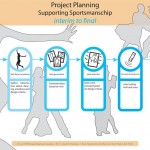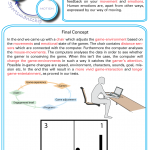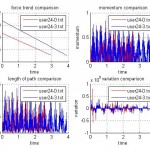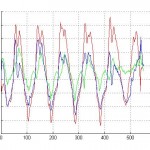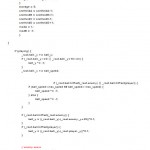Project Supporting Sportsmanschip
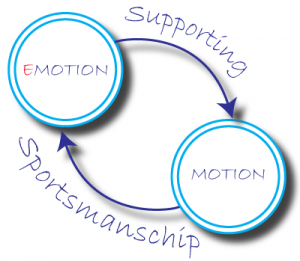 Project Supporting Sportsmanschip
Project Supporting Sportsmanschip
Coach: Emilia Barakova
Theme: Social robots & Humanoids
Project description:
This project was about designing a training robot for sportsman that not only trains your skills, but also motivates you, by for instance giving feedback on your movement and emotions. Human emotions are, apart from other ways, expressed by our way of moving. Recent research has proved that it is possible to track the emotional characteristics of human movement. The design outcome of this project has to be based on this theory.
Concept description:
In the end we came up with a chair which adjusts the game-environment based on the movements of the gamer. The chair contains distance sensors which are connected with the computer. Furthermore the computer analyses the mouse-movements. The computers analyses the data in order to see whether the gamer is conceiving the game. When this isn’t the case, the computer will change the game-environment in such a way it catches the gamers’ attention. In the end this will result in a more vivid game-interaction and longer game-entertainment. More information can be read in the report.
Reflection
Project
The supporting Sportsmanship was my second second year’s project. This enabled me to apply to goals I made in advance and to go deeper into certain design phases since in previous projects there was no opportunity to this due the short project-periods. During the project I was engaged in creating prototypes integrating technology, performing user testing, visualizing, multidisciplinary teamwork and data analyzing. Overall seen this project made me aware of the importance of academically reasoning behind concepts and what pitfalls can occur during user testing.
Ideas & Concepts
During the project we came up with a few concepts, but required experts in this area were not available. Because deadlines ware approaching we used the co-reflection method on ourselves, which is comparable with interviewing in order to validate the concepts in an objective way. I learned that this method is very useful to determine the user in its context (like what are the values?), to determine possible improvements addressed by the user and finally to judge possible concepts by guiding the questioner in an objective way.
Integrating Technology
 During the project I was involved creating an interactive prototype, which included programming a Ping Pong game in Flash and using input from the mouse and distance sensors. In previous Flash creations I used movie clips (animated visualizations or based on values of Phidgets sensors) which is kind of prescribed of what I programmed. However during this project I learned how to use different methods in Flash to exchange data and how to program artificial intelligence using intelligent algorithms (in action script 2.0). This enables me to design adaptive Flash creations using programmed intelligence, as you can try out below. Furthermore I extended my tools for creating interactive prototypes. By using Flash and my laptop I’m now able to use the acceleration-sensors and buttons of the Wii-mote to create wireless interactive prototypes.
During the project I was involved creating an interactive prototype, which included programming a Ping Pong game in Flash and using input from the mouse and distance sensors. In previous Flash creations I used movie clips (animated visualizations or based on values of Phidgets sensors) which is kind of prescribed of what I programmed. However during this project I learned how to use different methods in Flash to exchange data and how to program artificial intelligence using intelligent algorithms (in action script 2.0). This enables me to design adaptive Flash creations using programmed intelligence, as you can try out below. Furthermore I extended my tools for creating interactive prototypes. By using Flash and my laptop I’m now able to use the acceleration-sensors and buttons of the Wii-mote to create wireless interactive prototypes.
Normal Pong Game, static game: Pong
Intelligent Pong game, dynamic game adaptive on gamers engagement: P0ng adaptive
User Focus & Perspective
During the project we performed a user test to check whether it is possible to distinguish the emotional states of the user by capturing the waving-movements with the Wii-mote. In order to bring the user in a certain emotional state we showed them fragments of corresponding movies (thriller, comedy). Afterwards the users had to wave a few seconds with the Wii-mote and had to fill in what their emotional state was on a questionnaire.
However looking back we could have done better, because the results didn’t gave us the results we expected, which was partly our fault. We tried our best to let the user not get effected by surrounds sounds because we performed this test in a closed room. However I assume that it would have been better to put the user in a closed room alone, because I think the users were affected by our presence. In addition I learned it was useful to use this questionnaire so we were able to compare these results with the results we got from the Wii-mote analyzing. I also learned that it might have been better to record the whole user test on video, so we were able to fall back on the information recorded on video. In that case we could use motion-tracking for instance to post-analyze specific movement on the video. This all might have led to into more reliable results. Unless we performed the test a few times in advance ourselves, I learned that we have to perform the whole cycle of the user test ourselves. I became aware while trying out the user test ourself, I should also post-analyze the data in order to check whether everything is functional (also when an expert saying so). In addition I can conclude we had to contact multiple experts before performing the user test. Contacting a single expert does not automatically mean that the approach is correct in every perspective. I will take this all in mind the next time I performing a user test. More information about the user test and the outcomes can be read in the report.
Form & Senses
During the project I took responsibility for the project report, because one of my goals was to become more experienced with Adobe’s InDesign and apply the experience from the Designing your Report assignment. I became aware that InDesign is a very powerful tool to create professional papers without restricting my creativity. I learned how to make use of Master-Pages, page-numbers, character and paragraph styles and how to create an automated page of content including clickable links. I also applied this knowledge while designing my Portfolio and reports for other assignments. Another goal was to become more experienced in using Illustrator. I had a little bit of experience before, but during this project and an Illustrator workshop I engaged myself in making illustrations for the posters and report. I’m now more experienced with Illustrator. It enables me to create high quality poster, flyers or leaflets. However I should keep practicing using both applications to become more experienced with them. You can view some examples over here:
Multidisciplinary Teamwork & Communication
During the project I became aware it is important to contact multiple (at least 3) experts to discuss an activity. Contacting a single expert does not automatically mean that the approach is correct in every perspective. Furthermore I learned that as designer I have to make my own decisions about what to do next; I can make use of an expert in order to assist me and gather information. But it should not be the other way around. I learned that every coach and expert has different expectations of me (research vs. design) and it is up to me how far I should adapt myself into it. In addition it is very important to make sure I understand everything while talking with an expert. An expert can give me a boost what to do; but without knowing what, how and why performing the next step I’m lacking of an academically approach. During the next project I will address to divide contacting multiple experts over the team.
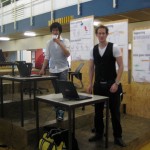 Concerning the teamwork, it was nice to work with everybody. Because we are friends of each other this resulted in a fluent cooperation. However this also resulted in less discussion about decisions between the team members. Looking back we could have been more critical sometimes and spend less time in achieving our learning goals, especially when other team members have the expertise to do it a lot faster.
Concerning the teamwork, it was nice to work with everybody. Because we are friends of each other this resulted in a fluent cooperation. However this also resulted in less discussion about decisions between the team members. Looking back we could have been more critical sometimes and spend less time in achieving our learning goals, especially when other team members have the expertise to do it a lot faster.
From the interim exhibition I learned it is better to use physical representations of my designs rather than using posters. During the final exhibition it was difficult to find a compromise between showing interactive concepts (interesting) and the loads of important research-data behind it (not interesting, but the main topic of our project). In my opinion it would have been better to show a movie for example to attract the audience’s attention and to summarize the important research the data behind the interactive prototypes. Eventually for the visitors it seems we did not work enough, but behind the scenes a lot happened about the reasoning behind our concept.
Design & Research Processes
Supporting Sportsmanschip project was mainly a research project. When selecting this project I thought this project would focus on creating interactive prototypes, which is part of my vision. However during this project I changed my vision and became aware it is also very important to come up with academically foundations for my designs. A lot of students are claiming that their designs are ‘intelligent’, without knowing the meaning and foundation of it. During the project we demonstrated that emotions can be captured to adapt the gaming-experience. You would expect that an engaging gamer is sitting in front of the chair and a bored gamer is leaning to the back. But according to research is proven it’s the other way around. This is vital input for developing concepts. Nevertheless I should take in mind that this requires a lot of time too. Evolving from a first years student towards my FBP I see that reasoning becomes more important in the design process.
During the project we used an explorative-design process and performed trail & error approaches by ourselves to provide foundation for our decisions. Exploring research by ourselves is educative and shows independence, but with deadlines approaching it would have been better to contact experts earlier, in order to spend more time on the concept development phases. In that case there was more time available to perform a second user test, but this time in a correct professional way. In real life as a designer I should also outsourcing tasks when I’m not able to do it myself. In the end I can conclude that another contradiction between performing our tasks ourselves and outsourcing them would have been better for this project. Also including personal deadlines will assist me to divide the phases of the design process better over time. I also think the absence of a client had a negative effect on the design direction.
Self-directed & Continuous Learning
During the project I became aware that the co-reflection method is very useful to reflected upon myself by interviewing myself and to come up with improvements in an objective way. Furthermore I learned it is important to do regular reflections to judge the project progression. I also became aware that I have to really engaged into the research process, even when there is no way out. By finding appropriate solutions for complications myself I’m able to become more independent and structured as a designer. In the end I see this effort as a reward for final outcome of the project.
Analyzing Complexity
The majority of our project time to dedicated to qualitative data-analyzing.
I became aware of several tools to analyze data on their quality, based on frequency and amplitude. The mean and median can get me started to filter useless data. Furthermore I became aware of powerful tools like the Russell’s Circumplex Model, Neural Network Analysis and Neural Gas Network to qualify the data. I also learned that it can be useful to plot data in a graph by using Mathlab. In that way I can cluster data and look at the results from another perspective. What’s more I learned that it is important to keep aware of what I’m doing with the data and what kind of data I’m talking about, especially with experts. Otherwise might get useless data, which is a waste of time for both parties. Furthermore I learned to program artificial intelligence by analyzing data from Phidgets and mouse movements and to use adaptive algorithms, as described in ‘integrating technology’.
In the end one of my goals was to become more aware of SPSS, a statistical application. Unfortunately, during this user test it was not possible to use this application for data-analyzing since everything was made in MathLab. Maybe during my internship or FBP I have the opportunity to accomplish this goal, because in my opinion an Industrial Designer from our University should be able to handle professional data-analyzing using professional tools.
